

Compact Muon Solenoid
LHC, CERN
| CMS-PAS-HIG-17-010 | ||
| Inclusive search for the standard model Higgs boson produced in pp collisions at √s= 13 TeV using H→bˉb decays | ||
| CMS Collaboration | ||
| May 2017 | ||
| Abstract: A search for the standard model Higgs boson produced with high transverse momentum decaying to a bottom quark-antiquark pair has been performed using a data set of pp collisions at √s= 13 TeV collected with the CMS experiment at the LHC. The data sample corresponds to an integrated luminosity of 35.9 fb−1. A high-transverse-momentum Higgs boson decaying to bˉb is reconstructed as a single jet and identified based on jet substructure and dedicated b-tagging techniques. The analysis strategy is validated with Z→bˉb decays. The Z→bˉb process is observed with a local significance of 5.1 standard deviations for the first time in the single jet topology. For a Higgs boson mass of 125 GeV, an excess of events is observed above the expected background with a local significance of 1.5 standard deviations. The measured cross section of H(bˉb) production for pT> 450 GeV is 74+51−49 fb. | ||
|
Links:
CDS record (PDF) ;
CADI line (restricted) ;
These preliminary results are superseded in this paper, PRL 120 (2018) 071802. The superseded preliminary plots can be found here. |
||
| Figures & Tables | Summary | Additional Figures | References | CMS Publications |
|---|
| Figures | |
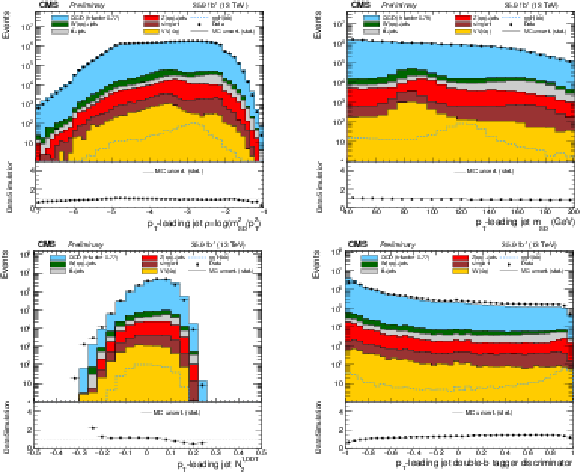
png pdf |
Figure 1:
Data to simulation comparison of the ρ (top-left), mSD (top-right), N1,DDT2 (bottom-left) and double-b tagger (bottom-right) variables, after the requirement on the jet pT and the online selection. |

png pdf |
Figure 1-a:
Data to simulation comparison of the ρ variable, after the requirement on the jet pT and the online selection. |
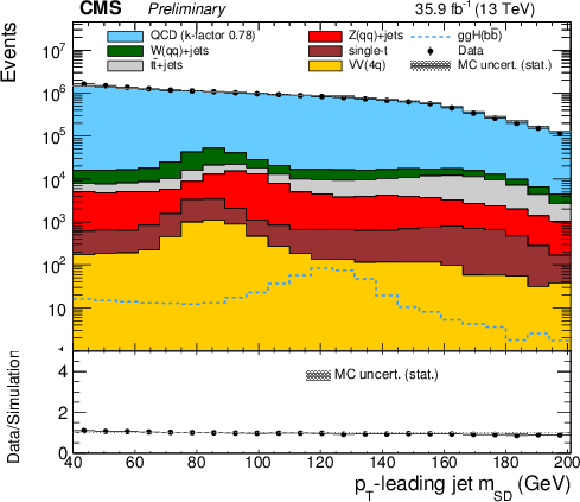
png pdf |
Figure 1-b:
Data to simulation comparison of the mSD variable, after the requirement on the jet pT and the online selection. |
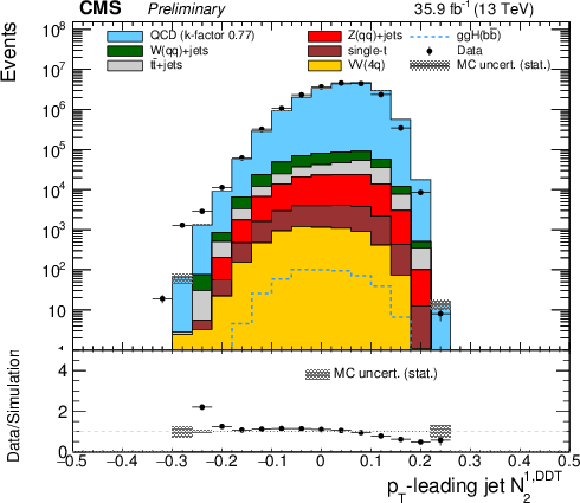
png pdf |
Figure 1-c:
Data to simulation comparison of the N1,DDT2 variable, after the requirement on the jet pT and the online selection. |

png pdf |
Figure 1-d:
Data to simulation comparison of the double-b tagger variable, after the requirement on the jet pT and the online selection. |

png pdf |
Figure 2:
The mSD distribution for simulated signal events after all the selection criteria in both the passing and failing regions. The yield for each process is normalized to its cross section. |
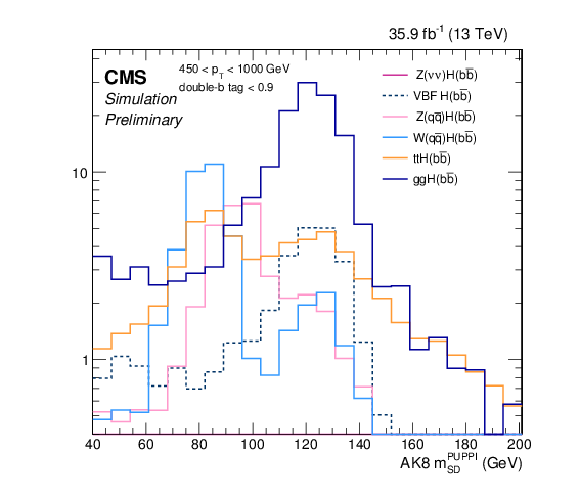
png pdf |
Figure 2-a:
The mSD distribution for simulated signal events after all the selection criteria in the passing region. The yield for each process is normalized to its cross section. |

png pdf |
Figure 2-b:
The mSD distribution for simulated signal events after all the selection criteria in the failing region. The yield for each process is normalized to its cross section. |

png pdf |
Figure 3:
double-b tagger vs. jet pT and mSD |

png pdf |
Figure 4:
Post-fit mSD distributions in data for the pass and fail regions and combined pT categories by using a polynomial 2nd order in ρ and 1st order in pT. The features at 166 GeV and 180 GeV in the mSD distribution are due to the kinematic selection on ρ, which affects each pT category differently. |
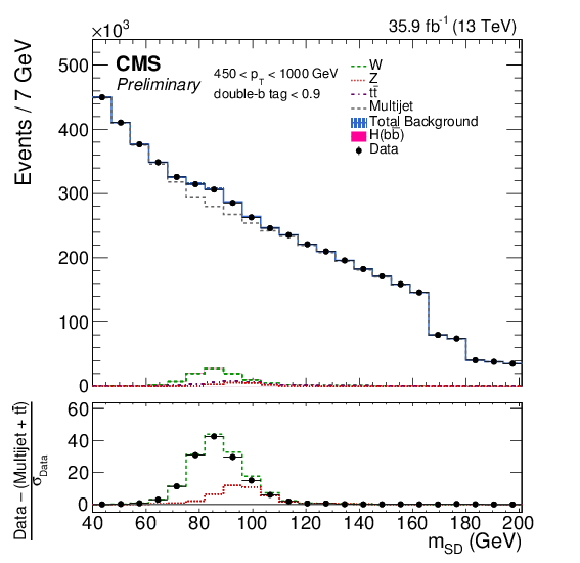
png pdf |
Figure 4-a:
Post-fit mSD distribution in data for the pass fail region and combined pT categories by using a polynomial 2nd order in ρ and 1st order in pT. The features at 166 GeV and 180 GeV in the mSD distribution are due to the kinematic selection on ρ, which affects each pT category differently. |
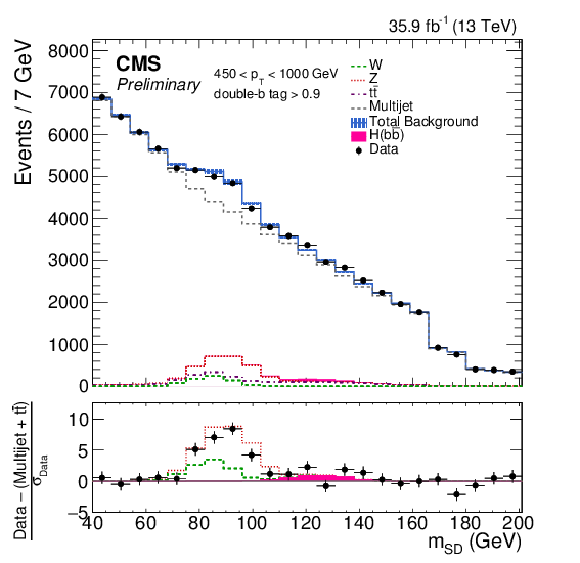
png pdf |
Figure 4-b:
Post-fit mSD distributions in data for the pass and fail regions and combined pT categories by using a polynomial 2nd order in ρ and 1st order in pT. The features at 166 GeV and 180 GeV in the mSD distribution are due to the kinematic selection on ρ, which affects each pT category differently. |

png pdf |
Figure 5:
Profile likelihood test statistic −2ΔlogL scan in data as a function of the H signal strength μH (upper left), Z signal strength μZ (upper right), and both signal strengths (μH,μZ) (lower). |
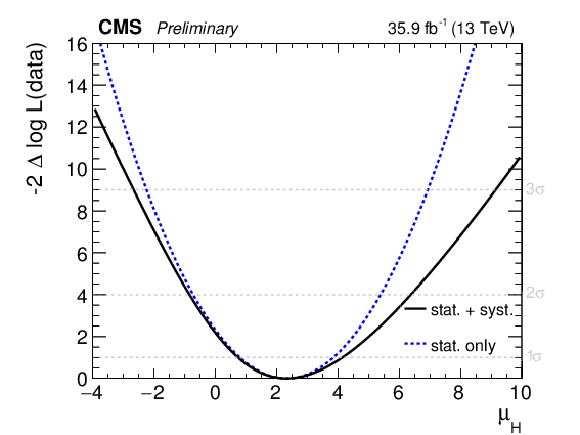
png pdf |
Figure 5-a:
Profile likelihood test statistic −2ΔlogL scan in data as a function of the H signal strength μH. |
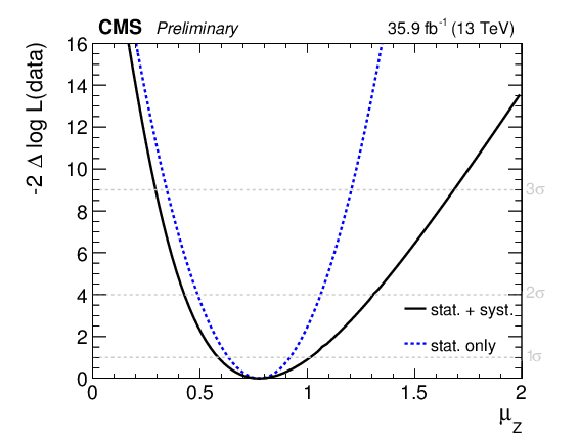
png pdf |
Figure 5-b:
Profile likelihood test statistic −2ΔlogL scan in data as a function of the Z signal strength μZ. |

png pdf |
Figure 5-c:
Profile likelihood test statistic −2ΔlogL scan in data as a function of both signal strengths (μH,μZ). |
| Tables | |
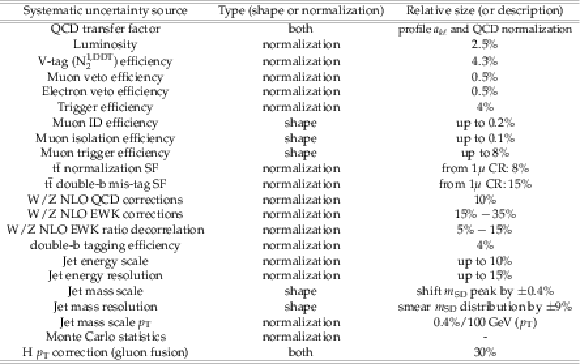
png pdf |
Table 1:
Systematic uncertainties and their relative size. |

png pdf |
Table 2:
Fitted signal strength and observed significance of the Higgs and Z signals. |
| Summary |
|
An inclusive search for the standard model Higgs boson decaying to bottom quark-antiquark pairs with pT> 450 GeV and reconstructed as a single jet has been presented using a data sample of proton-proton collisions collected by CMS corresponding to 35.9 fb−1 at √s= 13 TeV. The Higgs jets are reconstructed with the anti-kT algorithm with radius R= 0.8 and identified with the CMS double-b tag algorithm. The signal is then extracted on top of the falling QCD soft drop mass distribution (including contributions from W, Z, and top background processes) using an entirely data-driven QCD background prediction. The analysis strategy is validated by extracting the signal strength of the Z+jets process. The Z+jets process is observed for the first time in the single-jet topology with a significance of 5.1σ. The Higgs production is measured with a signal strength parameter of μH= 2.3+1.8−1.6 and an observed significance of 1.5σ (0.7σ expected for the standard model Higgs) when including Higgs pT spectrum corrections accounting for NLO and finite top mass effects. The measured cross section of the H(bˉb) production for pT> 450 GeV is 74+51−49 fb, which is consistent with the SM expectation within the uncertainty. |
| Additional Figures | |

png pdf |
Additional Figure 1:
Generator level Higgs pT distribution for the gluon fusion production mode. The CMS default POWHEG sample and the corrected spectrum to account for both higher order and finite top mass effects are compared. |

png pdf |
Additional Figure 2:
Soft drop jet mass (mSD) distribution for the different pT categories of the fit from 450-550 GeV (450-500, 500-550 from top to bottom). Data are shown as the black points. The QCD background prediction, including uncertainties, is shown in the gray boxes. Contributions from the W, Z, and H boson signal are indicated as well. In the bottom panel, the ratio of the data, after the subtraction of multijet and tˉt backgrounds, to its uncertainty is shown. The scale on the x-axis differs for each pT category due to the kinematic selection on ρ. |
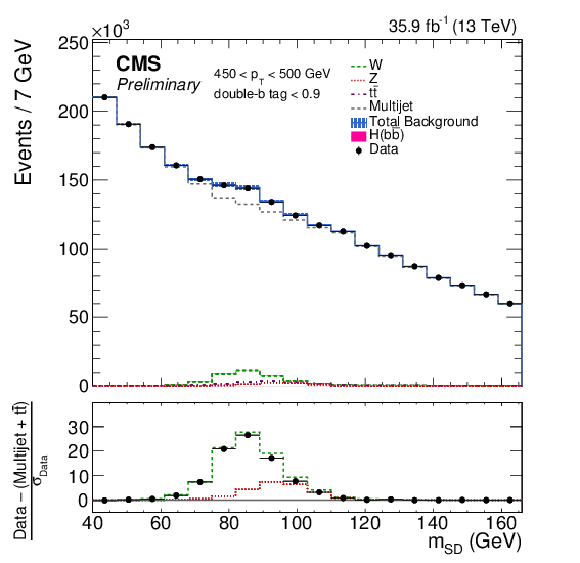
png pdf |
Additional Figure 2-a:
Soft drop jet mass (mSD) distribution for the pT category of the fit from 450-550 GeV, double b-tag > 0.9. Data are shown as the black points. The QCD background prediction, including uncertainties, is shown in the gray boxes. Contributions from the W, Z, and H boson signal are indicated as well. In the bottom panel, the ratio of the data, after the subtraction of multijet and tˉt backgrounds, to its uncertainty is shown. The scale on the x-axis differs for each pT category due to the kinematic selection on ρ. |

png pdf |
Additional Figure 2-b:
Soft drop jet mass (mSD) distribution for the pT category of the fit from 450-550 GeV, double b-tag < 0.9. Data are shown as the black points. The QCD background prediction, including uncertainties, is shown in the gray boxes. Contributions from the W, Z, and H boson signal are indicated as well. In the bottom panel, the ratio of the data, after the subtraction of multijet and tˉt backgrounds, to its uncertainty is shown. The scale on the x-axis differs for each pT category due to the kinematic selection on ρ. |

png pdf |
Additional Figure 2-c:
Soft drop jet mass (mSD) distribution for the pT category of the fit from 500-550 GeV, double b-tag > 0.9. Data are shown as the black points. The QCD background prediction, including uncertainties, is shown in the gray boxes. Contributions from the W, Z, and H boson signal are indicated as well. In the bottom panel, the ratio of the data, after the subtraction of multijet and tˉt backgrounds, to its uncertainty is shown. The scale on the x-axis differs for each pT category due to the kinematic selection on ρ. |

png pdf |
Additional Figure 2-d:
Soft drop jet mass (mSD) distribution for the pT category of the fit from 500-550 GeV, double b-tag < 0.9. Data are shown as the black points. The QCD background prediction, including uncertainties, is shown in the gray boxes. Contributions from the W, Z, and H boson signal are indicated as well. In the bottom panel, the ratio of the data, after the subtraction of multijet and tˉt backgrounds, to its uncertainty is shown. The scale on the x-axis differs for each pT category due to the kinematic selection on ρ. |

png pdf |
Additional Figure 3:
Soft drop jet mass (mSD) distribution for the different pT categories of the fit from 550-675 GeV (550-600, 600-675 from top to bottom). Data are shown as the black points. The QCD background prediction, including uncertainties, is shown in the gray boxes. Contributions from the W, Z, and H boson signal are indicated as well. In the bottom panel, the ratio of the data, after the subtraction of multijet and tˉt backgrounds, to its uncertainty is shown. The scale on the x-axis differs for each pT category due to the kinematic selection on ρ. |
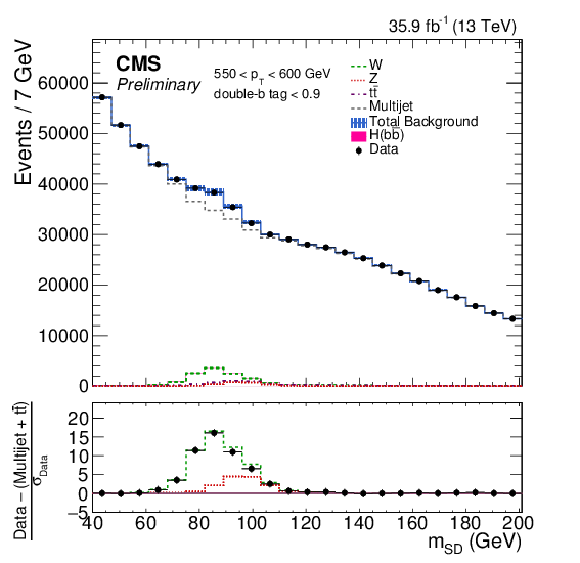
png pdf |
Additional Figure 3-a:
Soft drop jet mass (mSD) distribution for the pT category of the fit from 550-600 GeV, double b-tag < 0.9. Data are shown as the black points. The QCD background prediction, including uncertainties, is shown in the gray boxes. Contributions from the W, Z, and H boson signal are indicated as well. In the bottom panel, the ratio of the data, after the subtraction of multijet and tˉt backgrounds, to its uncertainty is shown. The scale on the x-axis differs for each pT category due to the kinematic selection on ρ. |
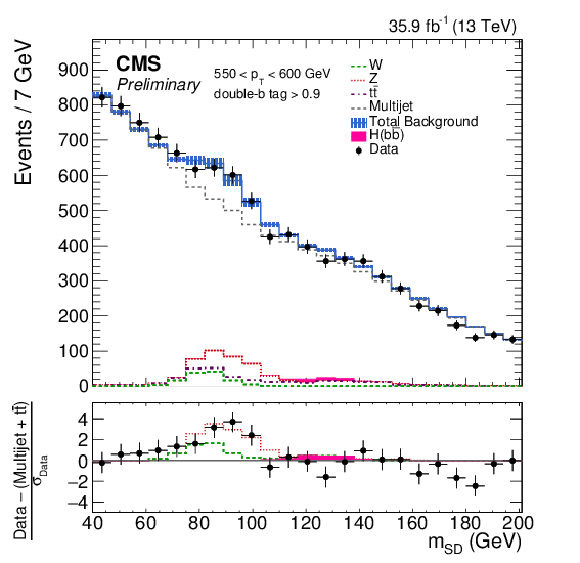
png pdf |
Additional Figure 3-b:
Soft drop jet mass (mSD) distribution for the pT category of the fit from 600-675 GeV, double b-tag > 0.9. Data are shown as the black points. The QCD background prediction, including uncertainties, is shown in the gray boxes. Contributions from the W, Z, and H boson signal are indicated as well. In the bottom panel, the ratio of the data, after the subtraction of multijet and tˉt backgrounds, to its uncertainty is shown. The scale on the x-axis differs for each pT category due to the kinematic selection on ρ. |

png pdf |
Additional Figure 3-c:
Soft drop jet mass (mSD) distribution for the pT category of the fit from 550-600 GeV, double b-tag < 0.9. Data are shown as the black points. The QCD background prediction, including uncertainties, is shown in the gray boxes. Contributions from the W, Z, and H boson signal are indicated as well. In the bottom panel, the ratio of the data, after the subtraction of multijet and tˉt backgrounds, to its uncertainty is shown. The scale on the x-axis differs for each pT category due to the kinematic selection on ρ. |
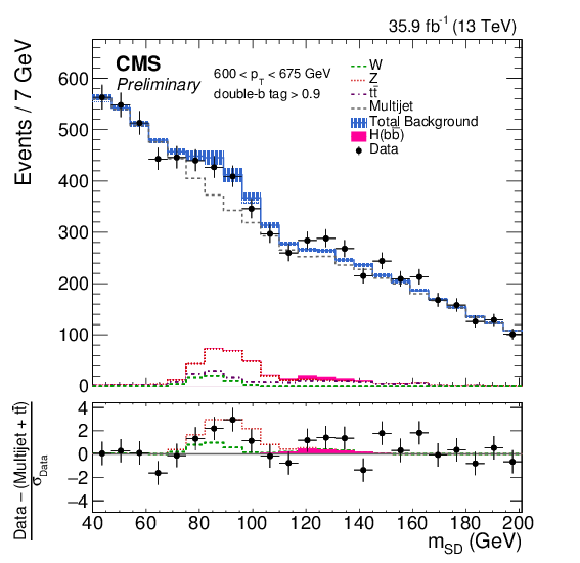
png pdf |
Additional Figure 3-d:
Soft drop jet mass (mSD) distribution for the pT category of the fit from 600-675 GeV, double b-tag > 0.9. Data are shown as the black points. The QCD background prediction, including uncertainties, is shown in the gray boxes. Contributions from the W, Z, and H boson signal are indicated as well. In the bottom panel, the ratio of the data, after the subtraction of multijet and tˉt backgrounds, to its uncertainty is shown. The scale on the x-axis differs for each pT category due to the kinematic selection on ρ. |

png pdf |
Additional Figure 4:
Soft drop jet mass (mSD) distribution for the different pT categories of the fit from 675-1000 GeV (675-800,800-1000 from top to bottom). Data are shown as the black points. The QCD background prediction, including uncertainties, is shown in the gray boxes. Contributions from the W, Z, and H boson signal are indicated as well. In the bottom panel, the ratio of the data, after the subtraction of multijet and tˉt backgrounds, to its uncertainty is shown. The scale on the x-axis differs for each pT category due to the kinematic selection on ρ. |
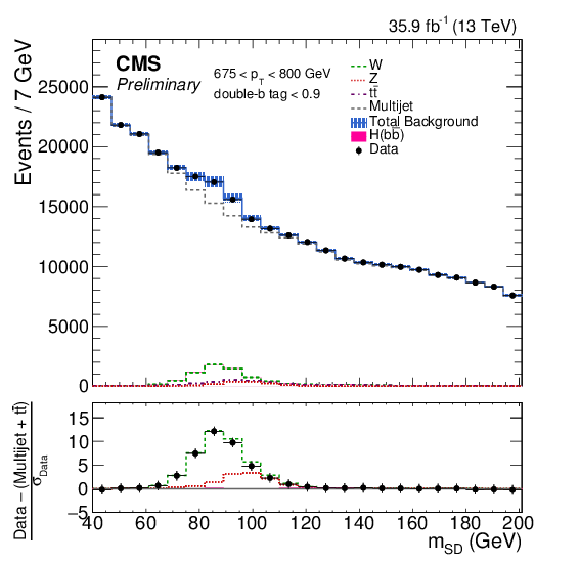
png pdf |
Additional Figure 4-a:
Soft drop jet mass (mSD) distribution for the different pT category of the fit from 675-800 GeV, double b-tag < 0.9. Data are shown as the black points. The QCD background prediction, including uncertainties, is shown in the gray boxes. Contributions from the W, Z, and H boson signal are indicated as well. In the bottom panel, the ratio of the data, after the subtraction of multijet and tˉt backgrounds, to its uncertainty is shown. The scale on the x-axis differs for each pT category due to the kinematic selection on ρ. |
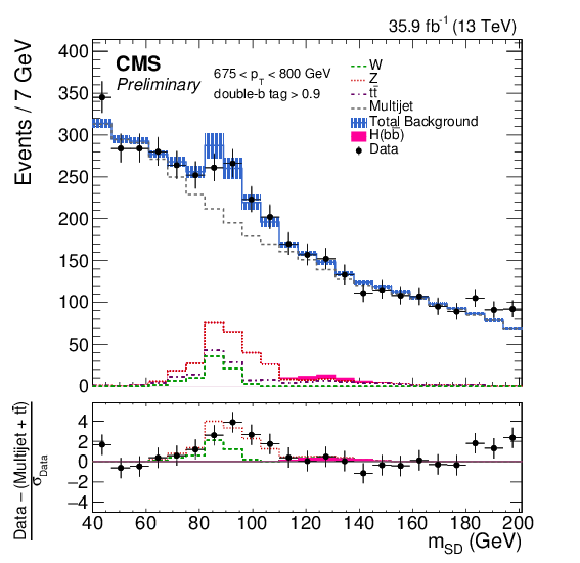
png pdf |
Additional Figure 4-b:
Soft drop jet mass (mSD) distribution for the different pT category of the fit from 675-800 GeV, double b-tag > 0.9. Data are shown as the black points. The QCD background prediction, including uncertainties, is shown in the gray boxes. Contributions from the W, Z, and H boson signal are indicated as well. In the bottom panel, the ratio of the data, after the subtraction of multijet and tˉt backgrounds, to its uncertainty is shown. The scale on the x-axis differs for each pT category due to the kinematic selection on ρ. |

png pdf |
Additional Figure 4-c:
Soft drop jet mass (mSD) distribution for the different pT category of the fit from 800-1000 GeV, double b-tag < 0.9. Data are shown as the black points. The QCD background prediction, including uncertainties, is shown in the gray boxes. Contributions from the W, Z, and H boson signal are indicated as well. In the bottom panel, the ratio of the data, after the subtraction of multijet and tˉt backgrounds, to its uncertainty is shown. The scale on the x-axis differs for each pT category due to the kinematic selection on ρ. |
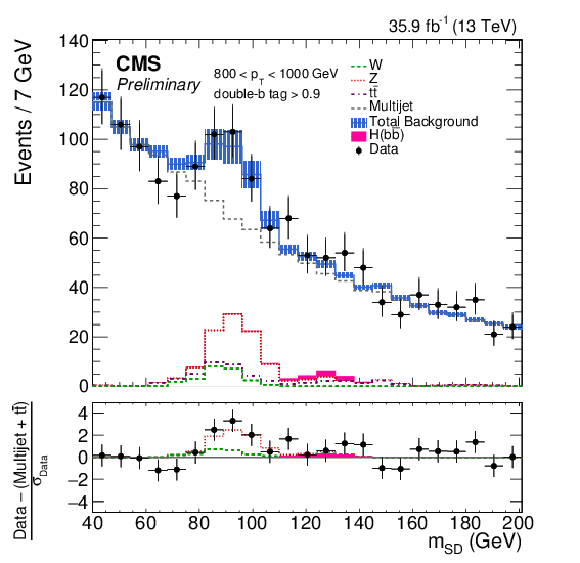
png pdf |
Additional Figure 4-d:
Soft drop jet mass (mSD) distribution for the different pT category of the fit from 800-1000 GeV, double b-tag > 0.9. Data are shown as the black points. The QCD background prediction, including uncertainties, is shown in the gray boxes. Contributions from the W, Z, and H boson signal are indicated as well. In the bottom panel, the ratio of the data, after the subtraction of multijet and tˉt backgrounds, to its uncertainty is shown. The scale on the x-axis differs for each pT category due to the kinematic selection on ρ. |
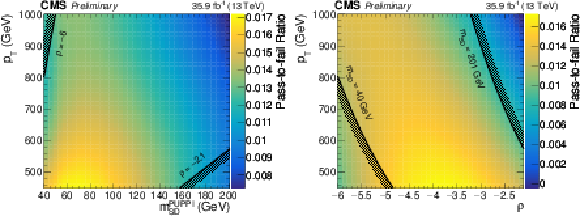
png pdf |
Additional Figure 5:
The two-dimensional polynomial transfer factor F is shown as function of mSD and pT (left) and ρ and pT (right). |
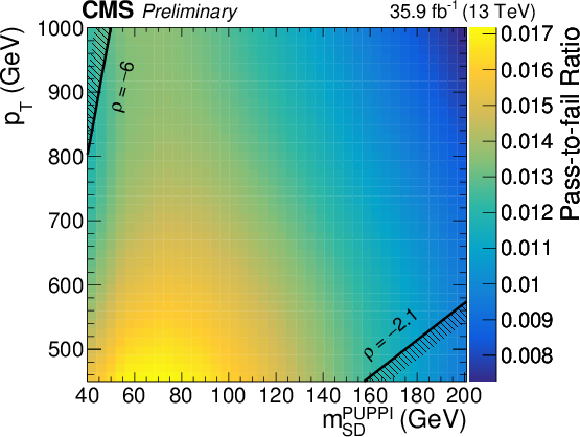
png pdf |
Additional Figure 5-a:
The two-dimensional polynomial transfer factor F is shown as function of mSD and pT. |
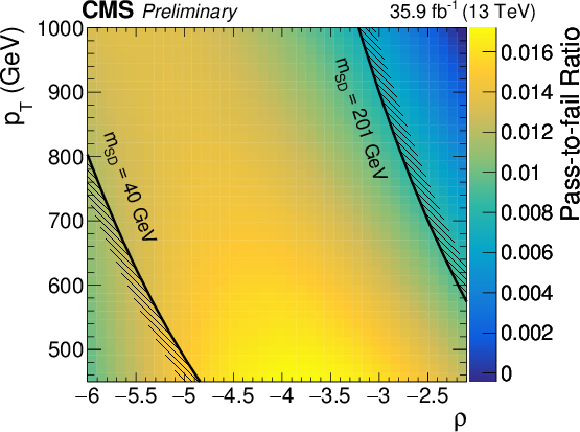
png pdf |
Additional Figure 5-b:
The two-dimensional polynomial transfer factor F is shown as function of ρ and pT. |

png pdf |
Additional Figure 6:
Fitted signal strengths for the Higgs and Z boson signals for each pT category by floating the Z and H signal strength parameter respectively. |

png pdf |
Additional Figure 6-a:
Fitted signal strengths for the Higgs signal for each pT category by floating the Z and H signal strength parameter respectively. |
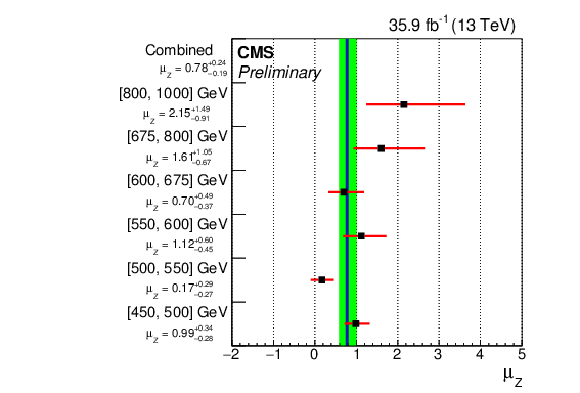
png pdf |
Additional Figure 6-b:
Fitted signal strengths for the Z boson signal for each pT category by floating the Z and H signal strength parameter respectively. |

png pdf |
Additional Figure 7:
N1,DDT2 transformation map as a function of the jet ρ and pT. The map corresponds to the 26% quantile of the N12 distribution in simulated QCD multijet events. The N12 distribution is mostly insensitive to the jet ρ and pT in the kinematic phase space considered for this analysis (−6<ρ<2.1) and further decorrelated yielding the N1,DDT2 variable. |
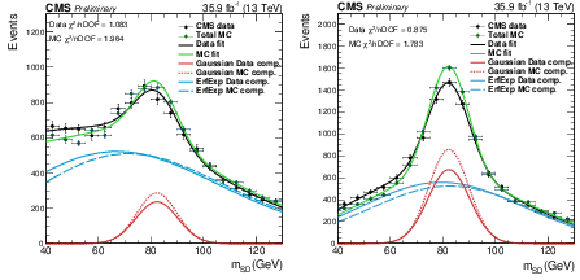
png pdf |
Additional Figure 8:
Soft-drop jet mass distribution that pass (left) and fail (right) the N1,DDT2 selection in the semileptonic tˉt sample. Results of fits to data and simulation are shown. |

png pdf |
Additional Figure 8-a:
Soft-drop jet mass distribution that pass the N1,DDT2 selection in the semileptonic tˉt sample. Results of fits to data and simulation are shown. |
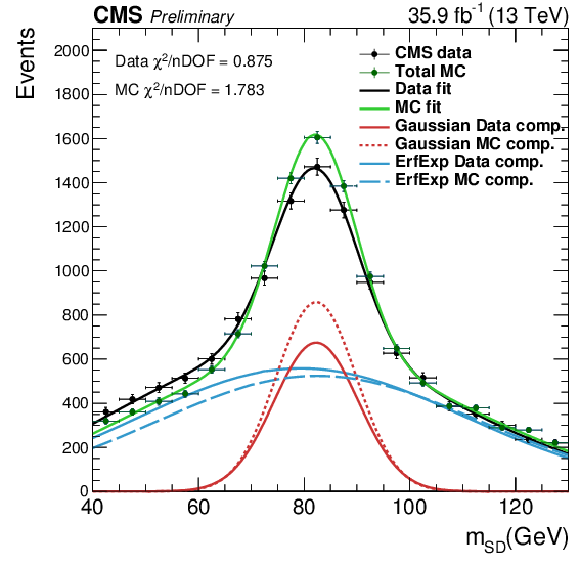
png pdf |
Additional Figure 8-b:
Soft-drop jet mass distribution that fail the N1,DDT2 selection in the semileptonic tˉt sample. Results of fits to data and simulation are shown. |
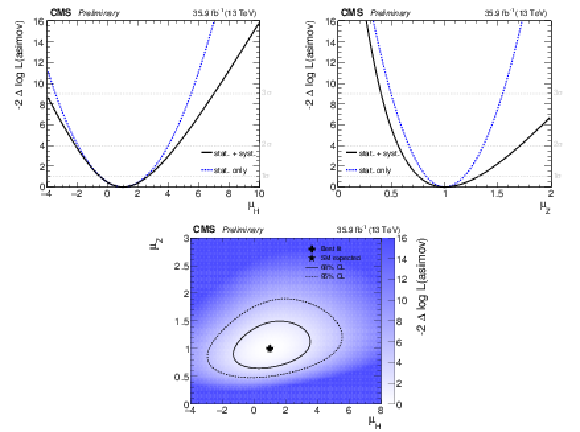
png pdf |
Additional Figure 9:
Profile likelihood test statistic −2ΔlogL scan on the post-fit Asimov dataset as a function of the H signal strength μH (upper left), Z signal strength μZ (upper right), and both signal strengths (μH,μZ) (lower). |
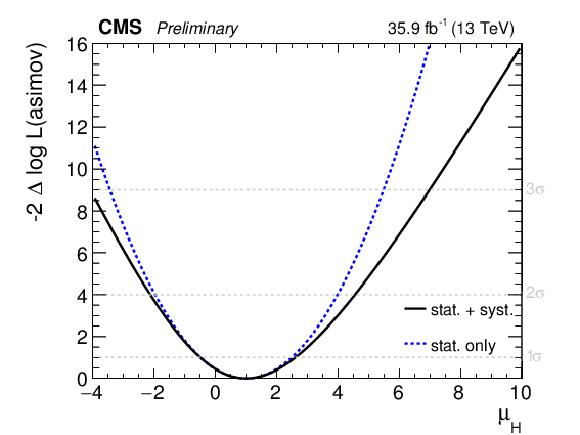
png pdf |
Additional Figure 9-a:
Profile likelihood test statistic −2ΔlogL scan on the post-fit Asimov dataset as a function of the H signal strength μH. |
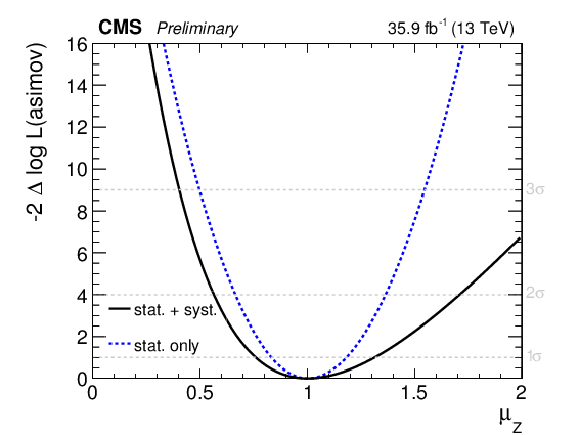
png pdf |
Additional Figure 9-b:
Profile likelihood test statistic −2ΔlogL scan on the post-fit Asimov dataset as a function of the Z signal strength μZ. |

png pdf |
Additional Figure 9-c:
Profile likelihood test statistic −2ΔlogL scan on the post-fit Asimov dataset as a function of the both H and Z signal strengths (μH,μZ). |
| References | ||||
| 1 | A. Salam and J. C. Ward | On a Gauge Theory of Elementary Interactions | Nuovo Cim. 19 (1961) 165--170 | |
| 2 | S. Glashow | Partial Symmetries of Weak Interactions | Nucl. Phys. 22 (1961) 579--588 | |
| 3 | S. Weinberg | A Model of Leptons | PRL 19 (1967) 1264--1266 | |
| 4 | F. Englert and R. Brout | Broken Symmetry and the Mass of Gauge Vector Mesons | PRL 13 (1964) 321--323 | |
| 5 | P. W. Higgs | Broken Symmetries and the Masses of Gauge Bosons | PRL 13 (1964) 508--509 | |
| 6 | G. S. Guralnik, C. R. Hagen, and T. W. B. Kibble | Global Conservation Laws and Massless Particless | PRL 13 (1964) 585--587 | |
| 7 | CMS Collaboration | Observation of a new boson at a mass of 125 GeV with the CMS experiment at the LHC | PLB 716 (2012) 30--61 | CMS-HIG-12-028 1207.7235 |
| 8 | ATLAS Collaboration | Observation of a new particle in the search for the Standard Model Higgs boson with the ATLAS detector at the LHC | PLB 716 (2012) 1--29 | 1207.7214 |
| 9 | The ATLAS and CMS Collaborations Collaboration | Measurements of the Higgs boson production and decay rates and constraints on its couplings from a combined ATLAS and CMS analysis of the LHC pp collision data at √s = 7 and 8 TeV | Technical Report ATLAS-CONF-2015-044,CMS-PAS-HIG-15-002, CERN, Geneva | |
| 10 | LHC Higgs Cross Section Working Group Collaboration | Handbook of LHC Higgs Cross Sections: 4. Deciphering the Nature of the Higgs Sector | 1610.07922 | |
| 11 | J. M. Butterworth, A. R. Davison, M. Rubin, and G. P. Salam | Jet substructure as a new Higgs search channel at the LHC | PRL 100 (2008) 242001 | 0802.2470 |
| 12 | C. Grojean, E. Salvioni, M. Schlaffer, and A. Weiler | Very boosted Higgs in gluon fusion | JHEP 05 (2014) 022 | 1312.3317 |
| 13 | CMS Collaboration | The CMS experiment at the CERN LHC | JINST 3 (2008) S08004 | CMS-00-001 |
| 14 | GEANT4 Collaboration | GEANT4---a simulation toolkit | NIMA 506 (2003) 250 | |
| 15 | S. Frixione, P. Nason, and C. Oleari | Matching NLO QCD computations with parton shower simulations: the POWHEG method | JHEP 11 (2007) 070 | 0709.2092 |
| 16 | G. Luisoni, P. Nason, C. Oleari, and F. Tramontano | HW±/HZ + 0 and 1 jet at NLO with the POWHEG BOX interfaced to GoSam and their merging within MiNLO | JHEP 10 (2013) 083 | 1306.2542 |
| 17 | J. Alwall et al. | The automated computation of tree-level and next-to-leading order differential cross sections, and their matching to parton shower simulations | JHEP 07 (2014) 079 | 1405.0301 |
| 18 | J. Alwall et al. | Comparative study of various algorithms for the merging of parton showers and matrix elements in hadronic collisions | EPJC 53 (2008) 473--500 | 0706.2569 |
| 19 | P. Nason | A new method for combining NLO QCD with shower Monte Carlo algorithms | JHEP 11 (2004) 040 | hep-ph/0409146 |
| 20 | S. Frixione, P. Nason, and C. Oleari | Matching NLO QCD computations with Parton Shower simulations: the POWHEG method | JHEP 11 (2007) 070 | 0709.2092 |
| 21 | S. Alioli, P. Nason, C. Oleari, and E. Re | A general framework for implementing NLO calculations in shower Monte Carlo programs: the POWHEG BOX | JHEP 06 (2010) 043 | 1002.2581 |
| 22 | Sjostrand, Torbjorn and Mrenna, Stephen and Skands, Peter | PYTHIA 6.4 physics and manual | JHEP 05 (2006) 026 | hep-ph/0603175 |
| 23 | T. Sjostrand, S. Mrenna, and P. Z. Skands | A Brief Introduction to PYTHIA 8.1 | CPC 178 (2008) 852--867 | 0710.3820 |
| 24 | CMS Collaboration | Event generator tunes obtained from underlying event and multiparton scattering measurements | EPJC 76 (2016), no. 3, 155 | CMS-GEN-14-001 1512.00815 |
| 25 | P. Skands, S. Carrazza, and J. Rojo | Tuning PYTHIA 8.1: the Monash 2013 Tune | EPJC 74 (2014) 3024 | 1404.5630 |
| 26 | J. M. Campbell and R. K. Ellis | MCFM for the Tevatron and the LHC | NPPS 205-206 (2010) 10 | 1007.3492 |
| 27 | M. Czakon, P. Fiedler, and A. Mitov | Total Top-Quark Pair-Production Cross Section at Hadron Colliders Through O(α4S) | PRL 110 (2013) 252004 | 1303.6254 |
| 28 | S. Kallweit et al. | NLO electroweak automation and precise predictions for W+multijet production at the LHC | JHEP 04 (2015) 012 | 1412.5157 |
| 29 | S. Kallweit et al. | NLO QCD+EW predictions for V + jets including off-shell vector-boson decays and multijet merging | JHEP 04 (2016) 021 | 1511.08692 |
| 30 | S. Kallweit et al. | NLO QCD+EW automation and precise predictions for V+multijet production | in Proceedings, 50th Rencontres de Moriond, QCD and high energy interactions, 2015 | 1505.05704 |
| 31 | J. M. Lindert et al. | Precise predictions for V+jets dark matter backgrounds | 1705.04664 | |
| 32 | NNPDF Collaboration | Parton distributions for the LHC Run II | JHEP 04 (2015) 040 | 1410.8849 |
| 33 | U. Baur and E. W. N. Glover | Higgs Boson Production at Large Transverse Momentum in Hadronic Collisions | Nucl. Phys. B339 (1990) 38--66 | |
| 34 | D. de Florian, G. Ferrera, M. Grazzini, and D. Tommasini | Higgs boson production at the LHC: transverse momentum resummation effects in the H→2gamma, H→WW→lnulnu and H→ZZ→4l decay modes | JHEP 06 (2012) 132 | 1203.6321 |
| 35 | M. Grazzini and H. Sargsyan | Heavy-quark mass effects in Higgs boson production at the LHC | JHEP 09 (2013) 129 | 1306.4581 |
| 36 | E. Bagnaschi and A. Vicini | The Higgs transverse momentum distribution in gluon fusion as a multiscale problem | JHEP 01 (2016) 056 | 1505.00735 |
| 37 | R. Boughezal et al. | Higgs boson production in association with a jet at next-to-next-to-leading order in perturbative QCD | JHEP 06 (2013) 072 | |
| 38 | R. Boughezal et al. | Higgs boson production in association with a jet at NNLO using jettiness subtraction | PLB 748 (2015) 5--8 | 1505.03893 |
| 39 | R. Boughezal et al. | Color singlet production at NNLO in MCFM | 1605.08011 | |
| 40 | X. Chen, T. Gehrmann, N. Glover, and M. Jaquier | Higgs plus one jet production at NNLO | in Proceedings, 12th International Symposium on Radiative Corrections (Radcor 2015) and LoopFest XIV (Radiative Corrections for the LHC and Future Colliders), Los Angeles, 2016 | 1604.04085 |
| 41 | T. Neumann and C. Williams | The Higgs boson at high pT | PRD 95 (2017), no. 1, 014004 | 1609.00367 |
| 42 | M. Buschmann et al. | Mass Effects in the Higgs-Gluon Coupling: Boosted vs Off-Shell Production | JHEP 02 (2015) 038 | 1410.5806 |
| 43 | R. Frederix, S. Frixione, E. Vryonidou, and M. Wiesemann | Heavy-quark mass effects in Higgs plus jets production | JHEP 08 (2016) 006 | 1604.03017 |
| 44 | V. Hirschi and O. Mattelaer | Automated event generation for loop-induced processes | JHEP 10 (2015) 146 | 1507.00020 |
| 45 | N. Greiner et al. | Phenomenological analysis of Higgs boson production through gluon fusion in association with jets | JHEP 01 (2016) 169 | 1506.01016 |
| 46 | X. Chen, T. Gehrmann, E. W. N. Glover, and M. Jaquier | Precise QCD predictions for the production of Higgs + jet final states | PLB 740 (2015) 147--150 | 1408.5325 |
| 47 | R. Boughezal et al. | Higgs boson production in association with a jet at next-to-next-to-leading order | PRL 115 (2015), no. 8, 082003 | 1504.07922 |
| 48 | M. Cacciari et al. | Fully Differential Vector-Boson-Fusion Higgs Production at Next-to-Next-to-Leading Order | PRL 115 (2015), no. 8, 082002 | 1506.02660 |
| 49 | CMS Collaboration | Commissioning of the Particle-flow Event Reconstruction with the first LHC collisions recorded in the CMS detector | CDS | |
| 50 | M. Cacciari, G. P. Salam, and G. Soyez | The anti-kt jet clustering algorithm | JHEP 04 (2008) 063 | 0802.1189 |
| 51 | D. Bertolini, P. Harris, M. Low, and N. Tran | Pileup Per Particle Identification | JHEP 10 (2014) 059 | 1407.6013 |
| 52 | D. Krohn, J. Thaler, and L.-T. Wang | Jet Trimming | JHEP 02 (2010) 084 | 0912.1342 |
| 53 | M. Dasgupta, A. Fregoso, S. Marzani, and G. P. Salam | Towards an understanding of jet substructure | JHEP 09 (2013) 029 | 1307.0007 |
| 54 | A. J. Larkoski, S. Marzani, G. Soyez, and J. Thaler | Soft Drop | JHEP 05 (2014) 146 | 1402.2657 |
| 55 | CMS Collaboration | Jet algorithms performance in 13 TeV data | ||
| 56 | I. Moult, L. Necib, and J. Thaler | New Angles on Energy Correlation Functions | JHEP 12 (2016) 153 | 1609.07483 |
| 57 | A. J. Larkoski, G. P. Salam, and J. Thaler | Energy Correlation Functions for Jet Substructure | JHEP 06 (2013) 108 | 1305.0007 |
| 58 | J. Thaler and K. Van Tilburg | Identifying Boosted Objects with N-subjettiness | JHEP 03 (2011) 015 | 1011.2268 |
| 59 | CMS Collaboration Collaboration | Identification of double-b quark jets in boosted event topologies | Technical Report CMS-PAS-BTV-15-002, CERN, Geneva | |
| 60 | CMS Collaboration | Determination of jet energy calibration and transverse momentum resolution in CMS | JINST 6 (2011) 11002 | CMS-JME-10-011 1107.4277 |
| 61 | CMS Collaboration | CMS Luminosity Measurement for the 2015 Data Taking Period | CMS-PAS-LUM-15-001 | CMS-PAS-LUM-15-001 |

|
Compact Muon Solenoid LHC, CERN |

|

|

|

|

|

|